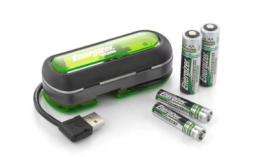Energizer Duo USB battery charger
(PhysOrg.com) -- The Energizer Duo USB battery charger has been hiding a backdoor Trojan in its software that affects computers using Windows. According to Symantec the Trojan has probably been there since 10th May 2007.
Energizer has now taken the software for the model CHUSB charger off the market and removed the site from which it could be downloaded, and the company is asking customers who downloaded the Windows version to uninstall it. There are easy steps to fight the Trojan in affected machines, and Macintosh users are not affected.
Symantec’s Director of Global Intelligence, Dean Turner, said it’s impossible to be certain the Trojan has always been in the software that monitors the Duo USB charger, but the Trojan’s binary header states it was created in May 2007. It is not known how the Trojan came to be in the software, but malware has previously been found to be hidden inside products. Energizer is working with the US Computer Emergency Readiness Team (US-CERT) and the US government to try to find out how the code found its way into the software.
The Trojan allows an attacker to operate with the same privileges as the user who is logged in, and to remotely control the system via connections on 7777/tcp to send and receive files, run programs, and list the contents of directories.
US-CERT advises that to fix the problem, users can delete the Arucer.dll file from the Windows system32 directory, and then restart the system. An alternative fix is to remove the USB charger software. The Trojan Arucer.dll file will still be present but the code cannot be executed in the absence of the charger software. It is also advisable to block access to port 7777 using a firewall or via network perimeter devices.
Energizer’s Duo USB battery chargers have been available in the US, Europe, Asia, and Latin America since 2007. They allow computer users to recharge the Nickel Metal Hydride (NiMH) batteries either from a wall outlet or a USB connection. It also enabled the user to monitor the status of charging on the PC.
© 2010 PhysOrg.com



















